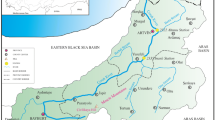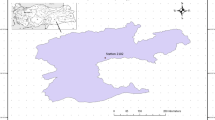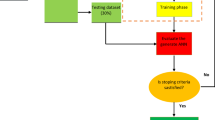Abstract
To project the structures to be built in the coastal zone and to make the best use of the coastal area, the mechanism of sediment transport, including both longshore and cross-shore transport, in this region should be well known. Within this context, temporal change rate of cross-shore sediment transport is of vital importance, especially to predict the erosion quantitatively. In this study, hybrid artificial intelligence models based on physical model data were established to determine the α coefficient used to describe the temporal change of cross-shore sediment transport. Teaching–learning-based optimization (TLBO) and artificial bee colony (ABC) algorithms were used for training of artificial neural network (ANN) in the model setup. Then, these models were compared with the classical back propagation ANN (ANN-BP) model. Wave height and period, bed slope and sediment diameter were considered as input parameters in the models. In all models, the used data for training and testing sets were 42 and 10 of total 52 experimental data, respectively. In the end of the analyses, it has been determined that the ANN-TLBO and ANN-ABC models have resulted in better results than the BP models. Also, the smallest mean absolute error and root mean square error values for testing set have been obtained from the ANN-TLBO model with 0.0068 and 0.0081, respectively. Therefore, it has been concluded that the best model ANN-TLBO can be successfully applied to predict the α coefficient.





Similar content being viewed by others
References
Watanabe A, Riho Y, Horikawa K (1980) Beach profiles and on-offshore sediment transport. In: Proceedings of the 17th International Conference on Coastal Engineering, pp 1106–1121
Larson M, Kraus NC (1989) SBEACH: numerical model for simulating storm-induced beach change. In: Report 1. Empirical foundation and model development (No. CERC-TR-89-9). Coastal Engineering Research Center Vicksburg Ms
Hsu TW (1998) Geometric characteristics of storm-beach profiles caused by inclined waves. Ocean Eng 25(1):69–84
Różyński G (2003) Data-driven modeling of multiple longshore bars and their interactions. Coast Eng 48(3):151–170
Günaydın K, Kabdaşlı MS (2003) Characteristics of coastal erosion geometry under regular and irregular waves. Ocean Eng 30(13):1579–1593
Günaydin K, Kabdasli MS (2005) Investigation of offshore bar geometry under regular and irregular waves. J Coast Res 21(2):374–382
Kömürcü Mİ, Özölçer İH, Yüksek Ö, Karasu S (2007) Determination of bar parameters caused by cross-shore sediment movement. Ocean Eng 34(5):685–695
Kömürcü Mİ, Tutkun N, Özölçer İH, Akpınar A (2008) Estimation of the beach bar parameters using the genetic algorithms. Appl Math Comput 195(1):49–60
Özölçer İH (2008) An experimental study on geometric characteristics of beach erosion profiles. Ocean Eng 35(1):17–27
Demirci M, Aköz MS (2012) An investigation on the formation of submerged bar under surges in sandy coastal region. China Ocean Eng 26(3):535–546
Demirci M, Akoz MS (2012) The effect of cross-shore sediment transport on bar parameters: an Experimental Study. Int J Ocean Syst Eng 2(1):1–7
Demirci M, Aköz MS (2013) Investigation of bar parameters occurred by cross-shore sediment transport. Int J Naval Archit Ocean Eng 5(2):277–286
Demirci M, Aköz MS, Üneş F (2014) Experimental investigation of cross-shore sandbar volumes. J Coast Conserv 18(1):11–16
Demirci M, Üneş F, Aköz MS (2015) Prediction of cross-shore sandbar volumes using neural network approach. J Mar Sci Technol 20(1):171–179
Kankal M (2004) Temporal Variation of Croos-Shore Sediment Transport, M.D. Thesis, Karadeniz Technical University Graduate School of Natural and Applied Sciences, Trabzon, Turkey (in Turkish)
Kankal M, Kömürcü MI, Yüksek Ö, Akpinar A (2012) Artificial neural networks for estimation of temporal rate coefficient of equilibrium bar volume. Indian J Marine Sci 41(1):45–55
Fahimi F, Yaseen ZM, El-shafie A (2016) Application of soft computing based hybrid models in hydrological variables modeling: a comprehensive review. Theor Appl Climatol, pp 1–29
Dwarakish GS, Rakshith S, Natesan U (2013) Review on applications of neural network in coastal engineering. Artif Intell Syst Mach Learn 5(7):324–331
Balas CE, Koç ML, Tür R (2010) Artificial neural networks based on principal component analysis, fuzzy systems and fuzzy neural networks for preliminary design of rubble mound breakwaters. Appl Ocean Res 32(4):425–433
Koç ML, Balas CE (2012) Genetic algorithms based logic-driven fuzzy neural networks for stability assessment of rubble-mound breakwaters. Appl Ocean Res 37:211–219
Prahlada R, Deka PC (2015) Forecasting of time series significant wave height using wavelet decomposed neural network. Aquat Procedia 4:540–547
Bayram A, Uzlu E, Kankal M, Dede T (2015) Modeling stream dissolved oxygen concentration using teaching–learning based optimization algorithm. Environ Earth Sci 73(10):6565–6576
Mandal S, Patil SG, Manjunatha YR, Hedge AV (2008) Application of neural networks in coastal engineering—an overwiew. In: The 12th International Conference of IACMAG –Goa, India, pp 1639–1645
Larson M (1996) Model of beach profile change under random waves. J Waterw Port Coast Ocean Eng 122(4):172–181
Rumelhart DE, Hinton GE, Williams RJ (1986) Learning representations by back–propagating errors. Nature 323:533–536
Yan B, Zhang QH, Wai OW (2008) Prediction of sand ripple geometry under waves using an artificial neural network. Comput Geosci 34(12):1655–1664
Tayfur G (2014) Soft computing in water resources engineering: Artificial neural networks, fuzzy logic and genetic algorithms. WIT Press, p 267
Karaboga D (2005) An idea based on honey bee swarm for numerical optimization. Technical report-tr06, Erciyes University, Engineering Faculty, Computer Engineering Department
Kankal M, Uzlu E (2016) Neural network approach with teaching–learning-based optimization for modelling and forecasting long-term electric energy demand in Turkey. Neural Comput Appl. https://doi.org/10.1007/s00521-016-2409-2
Uzlu E, Akpınar A, Özturk HT, Nacar S, Kankal M (2014) Estimates of hydroelectric generation using neural networks with the artificial bee colony algorithm for Turkey. Energy 69:638–647
Rao RV, Savsani VJ, Vakharia DP (2011) Teaching–learning-based optimization: a novel method for constrained mechanical design optimization problems. Comput Aided Des 43(3):303–315
Safarinejadian B, Gharibzadeh M, Rakhshan M (2014) An optimized model of electricity price forecasting in the electricity market based on fuzzy timeseries. Syst Sci Control Eng Open Access J 2(1):677–683
Topal U, Dede T, Öztürk HT (2017) Stacking sequence optimization for maximum fundamental frequency of simply supported antisymmetric laminated composite plates using teaching–learning-based OPTIMIZATION. KSCE J Civil Eng. https://doi.org/10.1007/s12205-017-0076-1
Dede T (2013) Optimum design of grillage structures to LRFD–AISC with teaching–learning based optimization. Struct Multidiscip Optim 48:955–964
Uzlu E, Kankal M, Akpınar A, Dede T (2014) Estimates of energy consumption in Turkey using neural networks with the teaching–learning-based optimization algorithm. Energy 75:295–303
Zhang K, Douglas BC, Leatherman SP (2004) Global warming and coastal erosion. Clim Change 64(1):41–58
Acknowledgements
This paper is dedicated to the memory of the late Dr. Murat İhsan KÖMÜRCÜ, who conducted the experimental study with big difficulty and passed away in February 2013.
Author information
Authors and Affiliations
Corresponding author
About this article
Cite this article
Kankal, M., Uzlu, E., Nacar, S. et al. Predicting temporal rate coefficient of bar volume using hybrid artificial intelligence approaches. J Mar Sci Technol 23, 596–604 (2018). https://doi.org/10.1007/s00773-017-0495-1
Received:
Accepted:
Published:
Issue Date:
DOI: https://doi.org/10.1007/s00773-017-0495-1




